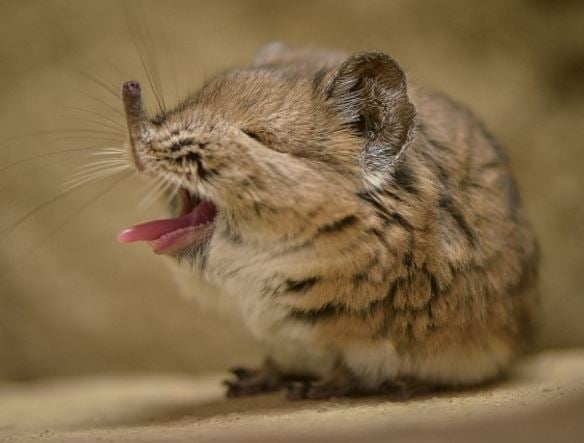Two round-eared elephant-shrews, also known as Sengis (Macroscelides proboscideus), have gone on show at Chester Zoo in England for the first time, and have charmed visitors with their adorable expressions.
The tiny mammals, that eat insects, shoots, and roots and have a gestation period of 56 days, were born at the zoo (a first) during the summer of 2015 in a special breeding facility that the general public did not have access to.
Surprisingly, these tiny creatures are not believed to be directly linked to their shrew cousins in other parts of the world. They are, in fact, more closely related to elephants and aardvarks.
 The round-eared elephant shrew is related to the elephant, which weighs 157,000 times more. (Image: Chester Zoo)
The round-eared elephant shrew is related to the elephant, which weighs 157,000 times more. (Image: Chester Zoo)
Round-eared elephant-shrews are one of the few mammals that have the same mate for life.
Related to elephants
Assistant team manager at Chester Zoo James Andrewes, said:
“They might look like a shrew but, fascinatingly, our new arrivals are in fact distantly related to manatees, aardvarks, hyraxes and elephants. In the past the species was commonly known as the elephant-shrew, but many biologists are now referring to them as sengi so as not to confuse them with true shrews.”
“They’re a really charismatic and intriguing little species and, having now had our first successes with encouraging them to breed, we’re beginning to learn more and more about them. In fact, there are nineteen different species of sengi, which are very poorly known in the wild and only as recently as last year a new species was discovered in Namibia.”
 This picture of an elephant-shrew yawning has made its way into thousands of websites across the world.
This picture of an elephant-shrew yawning has made its way into thousands of websites across the world.
Macroscelides proboscideus weighs between 30 and 45 grams (1 to 1.6 oz) and reaches about four inches in length, making it the smallest of the 19 sub-species in the family Macroscelididae.
They exist in the wild in South Africa, Botswana and Namibia, and can be found in scrublands, forests and deserts.
If you want to see them at Chester Zoo, go to its Secret World of the Okapi exhibit.
About Chester Zoo
Chester Zoo, operated by the North of England Zoological Society, is a zoological garden at Upton-by-Chester, in Cheshire, northern England.
It was named the best zoo in Britain and the 7th best globally in July 2015 by TripAdvisor.
 The sengi’s fur is grey brown, with a white underside. Its nostrils are at the tip of a flexible snout. (Image: Chester Zoo)
The sengi’s fur is grey brown, with a white underside. Its nostrils are at the tip of a flexible snout. (Image: Chester Zoo)
George Mottershead OBE (1894-1978) and his family opened Chester Zoo in 1931. He had been taken to Belle Vue Zoological Gardens in Manchester in 1903, and hated seeing the animals confined to small cages.
Mr. Mottershead’s ambition was to create a zoo with no bars. As a young man, he experimented with aviaries, tanks and runs for pet reptiles.
Today, Chester Zoo, which receives no government funding, covers an area of 125 acres (51 hectares). It has a total land holding of about 400 acres (160 hectares).
More than 1.4 million people visited the zoo in 2014, making it the most-visited wildlife attraction in the country. Forbes magazine described it as one of the top fifteen zoos in the world in 2007.
Video – Round-eared elephant-shrew
